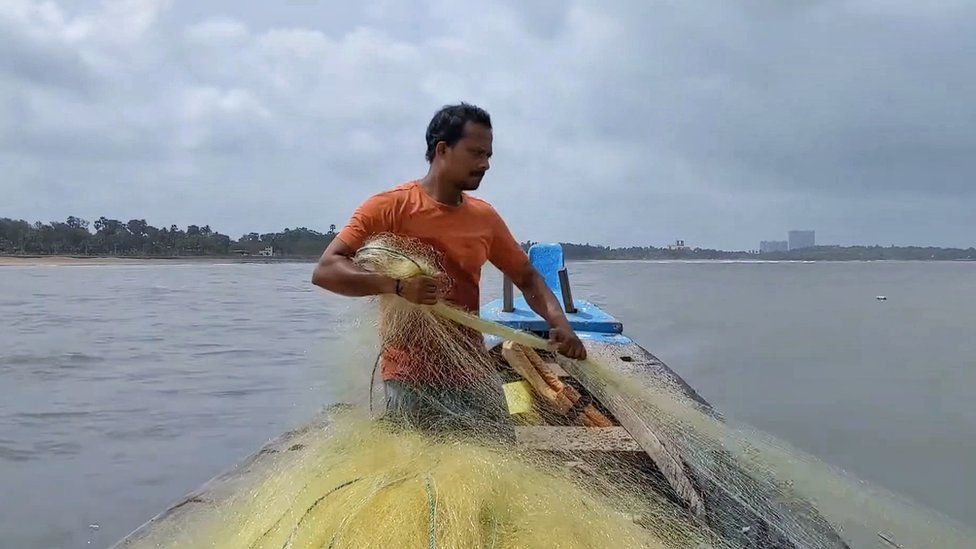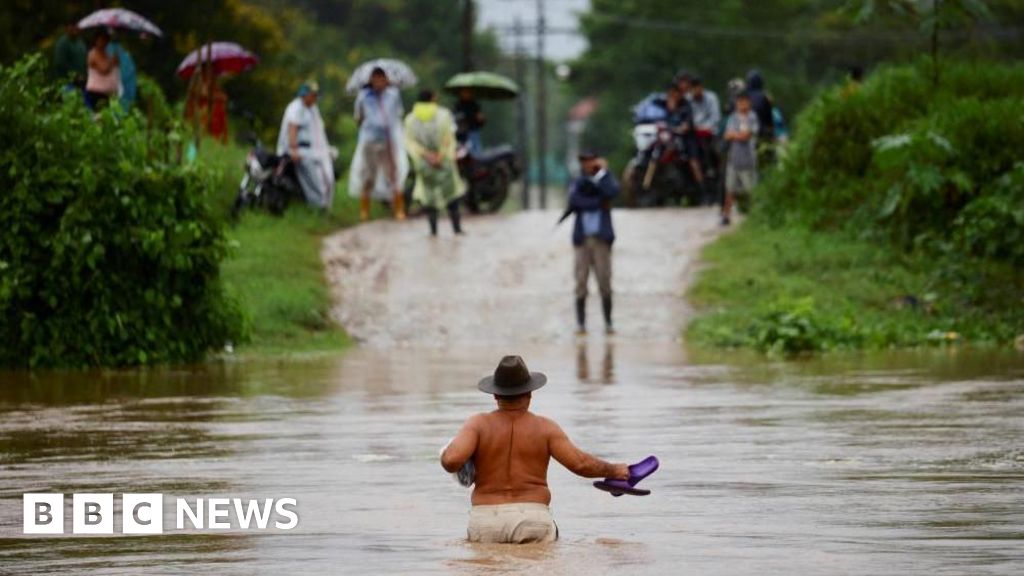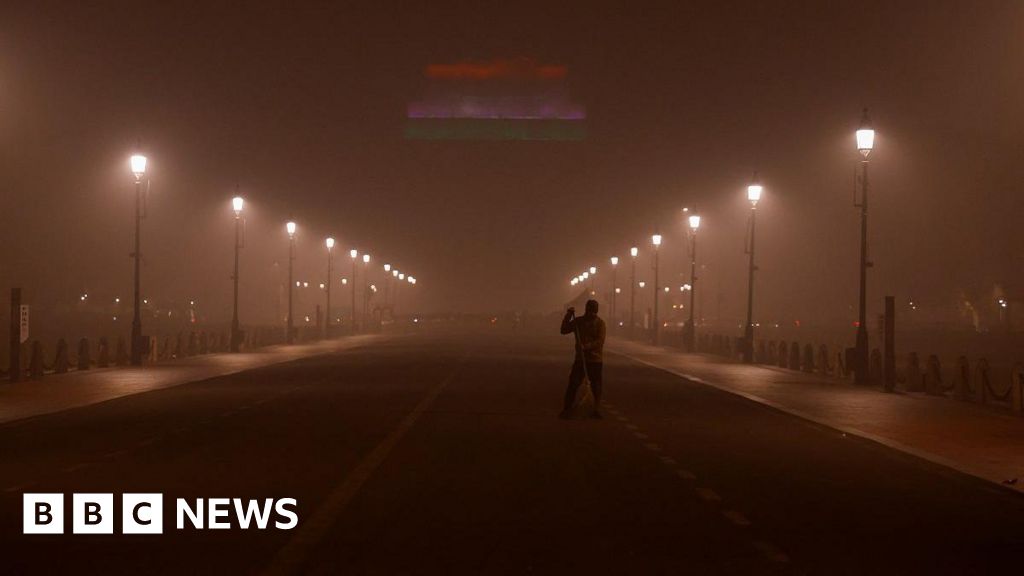ARTICLE AD BOX
By Janhavee Moole
BBC Marathi
 Image source, BBC Marathi
Image source, BBC Marathi
Darshan Kini has been fishing near Mumbai, along the western coast of India, for decades
Rising sea temperatures are directly affecting the livelihoods of fishermen and fish sellers along India's western coast who now have to make do with a diminishing catch.
"We spent hours at sea, but couldn't catch a single fish. Nothing in all five of our nets," Darshan Kini, a fisherman in the coastal city of Mumbai, said in frustration one morning last month.
The 36-year-old had just returned with his fellow fisherman to the harbour at Marve beach in the city's Malad suburb.
He has been going out to fish in this part of the Arabian Sea along the western coast of India with family elders since he was three or four years old.
But things have changed dramatically since Mr Kini's childhood.
"My grandfather used to tell me how big fish like sharks, sting-rays, and dolphins would roam here. Even as a child, we would put out any net and get a bucket of fish. But we haven't got a single fish today."
This summer, marked by extreme heat, fish seem to have almost disappeared from this creek.
Mumbai fishermen - or Kolis as they are called - could once find an abundance of fish just 2-3km (1.2-1.8 miles) out to sea. Now they must travel 30-40km to get the same variety.
But the increase in fuel prices makes this unaffordable for traditional fishermen like Mr Kini who must also deal with competition from big trawlers that overfish.
Further down the coast, in the southern state of Kerala, Baiju PB says his business has suffered due to frequent cyclones, particularly since 2017's Cyclone Ockhi - one of the worst to hit India's western coast.
Image source, BBC Marathi
Image caption,The decline in catch has driven up prices of fish to record highs
Mr Baiju, who owns a couple of fishing boats, says tarli or mathi - the famous sardines from the state - have nearly vanished from its coastal waters.
Between 1951 and 2015, the surface temperature of the Indian Ocean increased by 1C (33.8F) in the equatorial region at a rate of 0.15C per decade, a report by India's Ministry of Earth Sciences said.
This has led to an increase in the frequency of very severe cyclones along the western coast. Marine heatwaves have also been on the rise in this region.
And as the water heats up, fish migrate to new places.
"Just as we live in buildings, fish need a habitat to live in and corals provide this. But the changes in temperature are destroying the corals," marine biologist Vardhan Patankar explains.
The rise in temperature also affects the fertility of fish, he says.
"Many species of fish rely on different chemical signals for reproduction. Under certain conditions, males and females release their gametes at the same time, and new organisms are formed.
"But the increase in temperature changes the chemical composition of the ocean water. They can't release their gametes synchronously and the fish population depletes," he says.
The heat also kills phytoplankton, the food that fish survive on.
A 2020 report by the government's fisheries department said that the number of fish caught from the sea had increased in the past 10 years - from 3.2 million tonnes in 2010 to 3.7 million tonnes in 2020.
But these figures do not show the true picture, says Devendra Damodar Tandel of the All Maharashtra Fishermen's Action Committee.
Image source, BBC Marathi
Image caption,Fishermen in Mumbai say they could once find an abundance of fish just a couple of kilometres out to sea
"Instead of the total number for the year, we have to look at the months during which much of the fish has been caught," he says.
"Traditionally, fishing activities would stop for three months in monsoon because of their breeding season. But now fishing is banned for only two months. And yet, some boats still go to restricted areas to fish illegally."
Mr Tandel fears that this, coupled with changes in the sea, could make fish along the coast of Maharashtra extinct in two or three years.
People are not taking changes in the sea seriously yet, he says. "The trees are in front of us, so we care for them. But we don't see what's going on in the ocean."
The rise in sea temperatures is already having a direct impact on the livelihoods of fish sellers, particularly women, who are the backbone of this business.
There are 2.8 million people working in the fishing industry across India, with women accounting for nearly 70% of post-fishing activities such as cleaning and selling fish. The decline in catch directly affects their financial independence.
Image source, BBC Marathi
Image caption,Women account for nearly 70% of post-fishing activities, which include cleaning and selling fish
Nayana Bhandari, who has been selling fish in suburban Mumbai's Charkop market for several years, says that earlier they could live off her husband's earnings and whatever she made would go towards their savings. "But now we can't save anything."
The decrease in fish has also put one of the main food sources of the coastal region in crisis.
Prices of staple fish like pomfret are at a record high, says Manisha, a buyer at Mumbai's Malad fish market.
A pair of pomfret now sell for 2,500 rupees ($32; £26) in Malad's wholesale fish market, up 1,400 rupees from last year.
"In the past, we used to have different types of fish and it was bigger in size. We would eat fish three to four days a week. Now we can only afford it once or twice," she says.
Meanwhile, Mr Kini's family has started selling his catch on WhatsApp to make ends meet.
The monsoon reached the western coast of India in the last week of May, a few days earlier than usual. When fishing resumes after the rains, Mr Kini hopes the fish will return.
You may also be interested in:
Climate change: The Indian village that could disappear under water

 2 years ago
21
2 years ago
21








 English (US)
English (US)